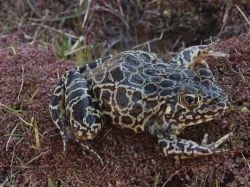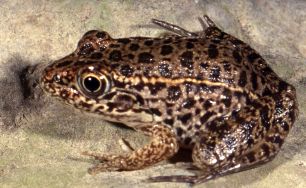Rana areolata (Baird & Girard, 1852)

Key Characters: Large head; mottled upper jaws; distinctively humped lower back when at rest; dark spots on back crowded together and encircled by light borders.
Similar Species: No other Illinois leopard frog has a dorsal pattern of multiple dark spots encircled by light borders and the humped back. See Key to Frogs & Toads of Illinois for help with identification.
Subspecies: Two subspecies are recognized, but only the Northern Crawfish Frog, R. a. circulosa (Rice and Davis, 1878), occurs in Illinois.

Description: Large (6.6-11 cm SVL) spotted frog with dorsolateral fold along each side of body. Entire belly unspotted white. Snout cone-shaped. Male has paired vocal pouches, at corners of jaw, and enlarged thumbs used for holding onto female during amplexus.
Natural History: Lives underground most of year in mammal burrows, storm drains, and abandoned crayfish burrows. Known to eat crayfish and small amphibians and reptiles, mostly at burrow entrances. Adults breed in pools during March-April, sometimes in large numbers. Breeding call is a loud, deep snore. Female lays 3,000-7,000 eggs. Tadpoles transform in midsummer.
Habitat and Distribution: Can be found in uncultivated former prairies, marshes, open bottomlands, and old field habitats, where it breeds in the still waters of wetlands, drainage ditches, flooded fields, and marshes. It is absent from mature upland forests and formerly or currently tilled fields. It is distributed along a wide band through central Illinois with a southward extension following the Mississippi River into southern Illinois.
Distribution Notes: Smith (1961) considered the crawfish frog an inhabitant of the “outlier prairies” of southern Illinois. These are the grasslands south of the Shelbyville Moraine underlain with clay soils. However, the populations of the mid-Mississippi Valley occupy a distinctly different habitat as do those of extreme southern Illinois in the Shawnee Hills division and the Mississippi Embayment.
Status: Formerly widespread in southern half of state. Uncommon and declining in some areas where breeding habitats have been drained or stocked with predatory fishes. Listed as a Species in Greatest Need of Conservation in the Illinois Wildlife Action Plan.
Etymology: Rana – rana (Greek) meaning frog; areolatus – (Latin) meaning ‘with small spaces’; circulosus – circuli (Latin) “circles, rings” and -osa (Latin) “full of”.
Original Description: areolatus: Baird, S.F. & C. Girard. 1852. Characteristics of some new reptiles in the museum of the Smithsonian Institution. Proceedings of the Academy of Natural Sciences, Philadelphia. 6:173
circulosus: Rice, F.L., and N.S. Davis. 1878. R. circulosa [In Addenda]. Jordan, D.S. ed., Manual of the Vertebrates of the Northern United States, Including the District East of the Mississippi River, and North of North Carolina and Tennessee, Exclusive of Marine Species. Second Edition, Revised and Enlarged: 355. Chicago, Jansen, McClurg & Company.
Type Specimen: areolatus: Syntypes, USNM; circulosus: not designated.
Type Locality: areolatus: restricted to Indianola, Calhoun County, Texas, USA by lectotype designation; circulosus: “Benton Co., Indiana”
Original Name: areolatus: Rana areolata Baird & Girard, 1852; circulosus: Rana circulosa Rice & Davis, 1878
Nomenclatural History: The Northern Crawfish Frog was originally described as a full species, but was later placed as a subspecies of areolatus. Illinois populations are currently considered L. a. circulosus.
Frost et al. (2006, Bull. Am. Mus. Nat. Hist., 297: 369) removed areolata (and most other North, Central, and South American ranids) from Rana and placed it in Lithobates based on extensive DNA sequence data, but not all workers agree with this arrangement because of the instability this brings to well-known taxa such as Rana catesbeiana. AmphibiaWeb recommends using Rana (Lithobates) areolata to demonstrate that it is a member of the subgenus Lithobates while preserving long-standing taxonomy.


